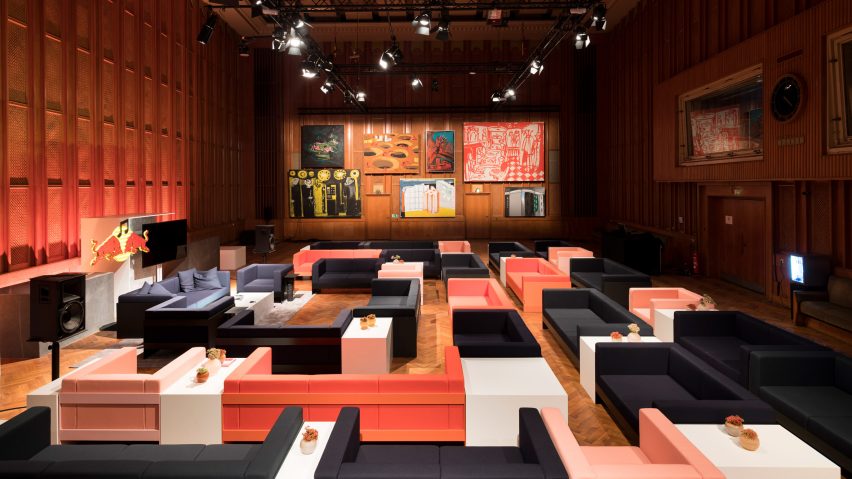Berlin-based design studio New Tendency has updated a GDR era broadcast building to create a temporary workspace for participants enrolled in Red Bull's music academy scheme.
New Tendency updated Berlin's Funkhaus, a former broadcasting centre for the German Democratic Republic (GDR) built in the 1950s by Bauhaus alumnus Franz Ehrlic, to host the annual Red Bull Music Academy.
Prior to New Tendency's intervention, the space underwent three months of renovation. The studio was tasked with creating spaces for the participants to work and relax, including a lobby, lecture theatre and recording studios.
"The idea was to get the building back to its original state and not interfere too much, as a form of respect for the architecture," New Tendency told Dezeen.
"With the furniture, we added a second layer to make it more contemporary and connect it to the ideas of the Red Bull Music Academy."
The lobby features a series of curved sofas, which help to break up the expansive space and create small islands of life. The designers wanted to create a feeling of intimacy, in order to encourage collaboration and friendship between the musicians.
"The whole building is designed around a circle, so the rounded couches are a homage to that," said the studio. "The idea was also to create rooms-in-rooms or islands, where people can sit together and form groups, rather than getting lost."
The sofas are made from steel and Kvadrat fabric in a bold orange colour, designed to contrast with the building's original heavy oak ceilings and marble floor. The designers also produced a series of modular counters, desks and side tables for the space.
"We developed furniture that is very solid, but also fragile at the same time," said the studio. "We got that idea from Bauhaus, which has a poetic side but also strong and powerful moments."
In the lecture hall, New Tendency arranged a cluster of sofas and low tables in a grid-like formation to complement a series of paintings by German artist Karl Hörst Hödicke, which hang on the walls. The paintings are part of a wider exhibition curated by Berlin gallerist Johann König to coincide with Red Bull's occupancy.
"We wanted to create an imaginary cube in the space," said the studio. "There is no hierarchy here, no stage or podium, which helps to build an intimate relationship between the lecturer and participants."
"That's the purpose of the academy – to connect closely with people you usually know from TV."
New Tendency furnished a lounge-style room overlooking the river Spree with dark green sofas from its own collection. Here, musicians can unwind and sample high-quality recordings using a leather-clad hi-fi turntable.
The designers also created audio equipment for the eight recording studios, which are housed inside the former radio station's original reverb chambers.
The main studio features functional design elements that are optimised for audio quality, such as shutters, a corridor that lead to a dead end and wooden staircases.
The renovation work was carried out by Red Bull, who rebuilt acoustic panels and fabrics for the studios and concert hall. The drinks company enlisted the help of interior designer Stephan Schilgen to restore the interior back to its original state. Mid-century furniture pieces were added in an homage to the building's heritage.
Outside, New Tendency installed a 70-metre steel bench that curves adjacent to the serpentine building, serving as an entrance pathway for guests. The bench is uncoated, in order to develop a patina over time that complements the building's brick facade.
Following Red Bull and New Tendency's intervention, Funkhaus will continue life as an events venue after the academy is finished for the year.
The Red Bull Music Academy, which runs an annual programme of lectures, radio broadcasts and city-wide festivals, is celebrating its 20th birthday.

